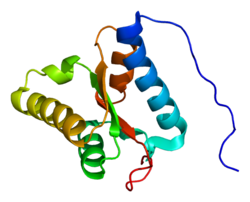- PELO
-
Pelota homolog (Drosophila) 
PDB rendering based on 1x52.Available structures PDB 1x52 Identifiers Symbols PELO; CGI-17; PRO1770 External IDs OMIM: 605757 MGI: 2145154 HomoloGene: 6835 GeneCards: PELO Gene Gene Ontology Molecular function • endonuclease activity
• protein binding
• hydrolase activity
• metal ion bindingCellular component • nucleus
• cytoplasmBiological process • translation
• cell cycle
• cell proliferation
• chromosome organization
• cell divisionSources: Amigo / QuickGO Orthologs Species Human Mouse Entrez 53918 105083 Ensembl ENSG00000152684 ENSMUSG00000042275 UniProt Q9BRX2 Q3TCN0 RefSeq (mRNA) NM_015946 NM_134058.3 RefSeq (protein) NP_057030 NP_598819.2 Location (UCSC) Chr 5:
52.08 – 52.1 MbChr 13:
115.88 – 115.88 MbPubMed search [1] [2] Protein pelota homolog is a protein that in humans is encoded by the PELO gene.[1][2]
This gene encodes a protein which contains a conserved nuclear localization signal. The encoded protein may have a role in spermatogenesis, cell cycle control, and in meiotic cell division.[2]
References
- ^ Shamsadin R, Adham IM, von Beust G, Engel W (Nov 2000). "Molecular cloning, expression and chromosome location of the human pelota gene PELO". Cytogenet Cell Genet 90 (1–2): 75–8. doi:10.1159/000015667. PMID 11060452.
- ^ a b "Entrez Gene: PELO pelota homolog (Drosophila)". http://www.ncbi.nlm.nih.gov/sites/entrez?Db=gene&Cmd=ShowDetailView&TermToSearch=53918.
Further reading
- Cheli Y, Kanaji S, Jacquelin B, et al. (2007). "Transcriptional and epigenetic regulation of the integrin collagen receptor locus ITGA1-PELO-ITGA2". Biochim. Biophys. Acta 1769 (9–10): 546–58. doi:10.1016/j.bbaexp.2007.06.004. PMC 2682338. PMID 17669516. http://www.pubmedcentral.nih.gov/articlerender.fcgi?tool=pmcentrez&artid=2682338.
- Ewing RM, Chu P, Elisma F, et al. (2007). "Large-scale mapping of human protein-protein interactions by mass spectrometry". Mol. Syst. Biol. 3 (1): 89. doi:10.1038/msb4100134. PMC 1847948. PMID 17353931. http://www.pubmedcentral.nih.gov/articlerender.fcgi?tool=pmcentrez&artid=1847948.
- Olsen JV, Blagoev B, Gnad F, et al. (2006). "Global, in vivo, and site-specific phosphorylation dynamics in signaling networks". Cell 127 (3): 635–48. doi:10.1016/j.cell.2006.09.026. PMID 17081983.
- Andersen JS, Lam YW, Leung AK, et al. (2005). "Nucleolar proteome dynamics". Nature 433 (7021): 77–83. doi:10.1038/nature03207. PMID 15635413.
- Gerhard DS, Wagner L, Feingold EA, et al. (2004). "The status, quality, and expansion of the NIH full-length cDNA project: the Mammalian Gene Collection (MGC)". Genome Res. 14 (10B): 2121–7. doi:10.1101/gr.2596504. PMC 528928. PMID 15489334. http://www.pubmedcentral.nih.gov/articlerender.fcgi?tool=pmcentrez&artid=528928.
- Ota T, Suzuki Y, Nishikawa T, et al. (2004). "Complete sequencing and characterization of 21,243 full-length human cDNAs". Nat. Genet. 36 (1): 40–5. doi:10.1038/ng1285. PMID 14702039.
- Strausberg RL, Feingold EA, Grouse LH, et al. (2003). "Generation and initial analysis of more than 15,000 full-length human and mouse cDNA sequences". Proc. Natl. Acad. Sci. U.S.A. 99 (26): 16899–903. doi:10.1073/pnas.242603899. PMC 139241. PMID 12477932. http://www.pubmedcentral.nih.gov/articlerender.fcgi?tool=pmcentrez&artid=139241.
- Lai CH, Chou CY, Ch'ang LY, et al. (2000). "Identification of novel human genes evolutionarily conserved in Caenorhabditis elegans by comparative proteomics". Genome Res. 10 (5): 703–13. doi:10.1101/gr.10.5.703. PMC 310876. PMID 10810093. http://www.pubmedcentral.nih.gov/articlerender.fcgi?tool=pmcentrez&artid=310876.
PDB gallery 
This protein-related article is a stub. You can help Wikipedia by expanding it.

